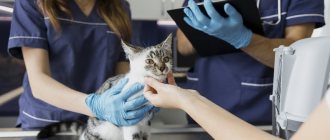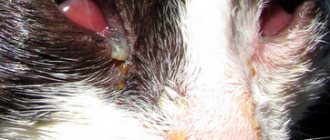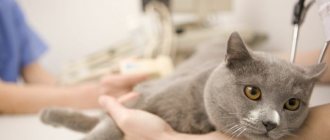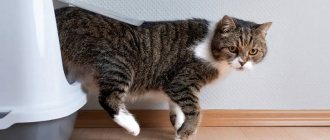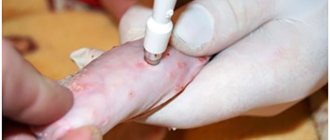The main symptom of bacterial or infectious effects on the animal’s body is inflammation of the lymph nodes in cats. They are necessary for filtering lymph from various impurities and act as reliable protection against various infections. If the pet did not have lymph nodes, this would contribute to the rapid damage to all organs in just one blood circulation cycle. To avoid problems, cat owners need to take a responsible approach to the health, care, nutrition and development of their own pets.
Description and signs
Lymphadenitis in cats is a disease that causes inflammation and enlargement of the lymph nodes. The lymph node acts as a protective function in such a way that this “filter” does not allow foreign elements to spread throughout the animal’s body. All lymph, before entering the blood, passes through the lymph nodes, which contain immune cells to form stable immunity. The location of inflammation in the lymph nodes indicates the development of the disease. First of all, those lymph nodes that are located closer to the source of inflammation occur.
Enlarged lymph nodes are accompanied by swelling, pain, and redness. Lymphadenitis in a cat can manifest itself in different ways, depending on the area of tumor formation. Thus, submandibular inflammation is characterized by difficulty in the process of absorbing food, and breathing problems may occur. Even an enlargement of one lymph node in the groin or in the axillary area leads to lameness of the animal. Cats with this disease regularly experience elevated temperatures, a feeling of fatigue, apathy, lethargy, and loss of appetite. Superficial swollen lymph nodes are noticeable with normal stroking with the hand.
If the cat owner detects such inflammation, it is recommended not to hesitate to visit the veterinarian.
What is the basis for the treatment of malignant tumors?
The basis of treatment for lymphomas is chemotherapy. Various schemes have been developed, their principle of action is based on the introduction of cytotoxic drugs, which should destroy all incorrectly and rapidly dividing cells.
The disadvantage of chemotherapy is that healthy cells, including bone marrow, gonads, and internal organs, are also exposed to toxic substances. Therefore, the dosage of medications is calculated strictly individually.
Cats with lymphoma should be closely monitored by their treating veterinary oncologist. Regularly monitor the level of leukocytes and enzymes in the blood, and monitor the growth or disappearance of the tumor during remission of the disease.
Causes and symptoms of inflammation
With inflammation of the lymph nodes, the pet suffers from weakness and drowsiness, which are accompanied by fever.
Lymphadenopathy is a general definition that characterizes the inflammatory process of several lymph nodes that are located in parallel for specific reasons. Veterinarians and scientists identify the following:
- Lymphadenitis. The main feature is the development of inflammation corresponding to the location of the diseased node. The disease may lead to an increase in body temperature, vomiting, diarrhea, weakness, and drowsiness.
- Oncological diseases. If the lymph nodes are swollen, then this is not a reliable sign of the formation of malignant tumors. To confirm or refute the diagnosis, it is necessary to perform a biopsy - pinching off a small part of the tumor for examination under a microscope.
Symptoms
With lymphadenitis in a cat, the inflamed nodes become hot to the touch compared to other areas of the body. If the lymph nodes are located on the neck, then the main symptom will be a sore throat and discomfort when swallowing in the animal. The cat may lose its appetite, but then its thirst increases and it drinks more water than usual. Also, with inflammation, the pet becomes apathetic, lethargic and drowsy, and refuses to play or engage in any activity.
With cancer problems, the symptoms are different. Thus, one node is capable of increasing to significant sizes. According to tactile sensations, the formations have a ribbed surface and initially, as the disease develops, no changes in the behavior and condition of the cat are observed, the reason for this is that the tumor at an early stage does not show all its negative effects.
Secrets of pathology diagnostics at the RosVet VC
When a cat is admitted with suspected lymphoma, diagnosis is a multi-step process. First, a veterinary oncologist conducts an external examination of the skin and mucous membranes, palpates the area of superficial lymph nodes, evaluates the animal’s appearance, its fatness and the quality of its coat.
Be sure to test the blood for carriage of the feline leukemia virus.
Laboratory blood tests reveal the presence/absence of anemia (drop in hemoglobin level), note the level of leukocytes and enzymes in the blood serum (lactate dehydrogenase, alkaline phosphatase, AlT, AST).
Improvements after chemotherapy for mediastinal lymphoma.
Ultrasound allows you to assess the size and condition of the internal lymph nodes in the abdominal cavity, thymus and lungs.
If altered lymph nodes are detected, cytological diagnostics are prescribed to find out the reason for their enlargement and the presence/absence of tumor cells.
For a biopsy, which is performed in an open manner, it is better to take a whole lymph node, so immunohistochemical and histological analysis will be more accurately carried out.
It is important to understand! All diagnostic procedures must be carried out. This is the only way to make a correct diagnosis, draw conclusions about the severity of the tumor process and develop optimal treatment for each patient with lymphoma admitted to the RosVet EC.
Diagnostics
Before taking an animal to a veterinary clinic, it is recommended to examine the cat yourself. It is necessary to pay attention to the following areas presented in the table:
| Body parts | Location and features of neoplasms |
| Maxillary department | The lesions often occur under the rounded part of the jaw |
| Elbow joint | Their structure resembles “cones” (bulges) |
| Appear on the forelimbs | |
| Knee cap | Located on the hind legs under the knee |
| Armpits | The nodes extend towards the head, they are easy to find by touch under the armpits of the front paws |
| Inguinal region | Formed in the groin, near the inside of the hip joint |
A doctor will help you make an accurate diagnosis by first drawing blood and urine for testing.
You can diagnose inflammation of the lymph nodes yourself by carefully palpating all areas of your pet’s body. If this is not enough, you need to seek help from a specialist and have your cat tested: blood, urine, biopsy. Only after such procedures can an accurate diagnosis be made and effective treatment or surgical removal of tumors prescribed.
Treatment of lymphadenitis in cats
Treatment is always aimed at eliminating the underlying cause of lymphadenitis. For example, if the submandibular lymph nodes are inflamed, it is necessary to treat diseases of the oral cavity, perhaps abscesses, stomatitis or dental problems.
If a systemic infection is detected, antibiotics and antivirals will be prescribed.
In case of purulent inflammation of the lymph node, surgical intervention, opening and drainage of the abscess will most likely be required.
Enlargement of lymph nodes can occur not only with inflammation, but also with cancer. It is important to accurately establish a diagnosis and prescribe competent treatment, and only a qualified doctor can do this.
Sign up for treatment of lymphadenitis
POLAR BEAR
The veterinary clinic in Nizhny Novgorod "White Bear" provides all types of services for cats and dogs.
Conducts any examinations and tests in its own veterinary laboratory; the clinic operates a veterinary ambulance for animals and a 24-hour veterinarian is on call at home. Agreement on the processing of personal data
Public offer
SITE MENU
- About the clinic
- Price list for veterinary clinic services
- Treatment
- Services
- Price list for veterinary clinic services
- Vetapteka
- Contacts
- Site Map
CONTACTS
- Nizhny Novgorod st. Vyatskaya 7
- 8 (831) 437-25-27
- [email protected]
Correct treatment of the disease
In case of infectious pathology, it is allowed to treat it at home, but in order to avoid complications, it is necessary to consult a veterinarian. You need to pay close attention to the cat’s diet, mood, general health and the process of emptying its intestines; if everything is normal, then there is no need to worry. If your cat's lymph nodes have been enlarged for a long time and continue to get larger, and the temperature is higher than expected, then it is recommended to consult a veterinarian.
After undergoing tests and making a diagnosis, the doctor prescribes complex medication therapy. It consists of antifungal medications and antibiotics, and a vitamin complex is also included. In some situations, the doctor sends the animal for a biopsy. If the diagnosis of oncology is confirmed, then treatment depends on the severity of the disease and the time when the tumor began to develop. In severe cases, surgery and chemotherapy may be prescribed. The fatal risk of developing cancer is almost 90 percent. Also, after successful treatment, it cannot be said that a relapse will not occur. When metastases spread throughout the body, it is recommended to euthanize the animal to free it from suffering and pain.
What is the danger?
Veterinarians clarify that enlarged lymph nodes in cats should not be ignored, since a violation can lead to serious consequences. Lymphadenopathy itself, if diagnosed and treated early, does not pose a threat to the animal and is easily eliminated.
In advanced cases, the functioning of many organs and systems may be disrupted, causing the pet’s general condition to rapidly deteriorate and possibly death. The greatest danger is represented by lymph nodes enlarged due to cancer. In 85% of cases, the animal cannot be saved and dies.
Caring for a sick cat
Unfortunately, there is no cure for this disease. In some cases, the only solution is to provide additional care to improve the quality of life of the affected animals.
It is important to closely monitor your cat's food and water intake while she is in the recovery phase.
The prognosis of this disease is highly variable and depends on the initial response to treatment, anatomical tumor type, FeLV status, and tumor burden.
If chemotherapy is started, you may need to check your cat regularly. At each visit, your veterinarian will perform blood tests to determine the response to treatment, as well as check the status of any complications arising from the treatment so that necessary adjustments can be made.
If chemotherapy drugs have been prescribed as part of your home treatment, be sure to follow the instructions carefully as chemotherapy drugs are very toxic to human health. Basic precautions include using latex gloves before taking the medicine.
If pain medications for cats have been prescribed, use them with caution and follow all instructions carefully, making sure all family members are familiar with the medication schedule; One of the most preventable pet disasters is drug overdose.
Survival times vary greatly, from several months to less than two years.
Briefly about the main thing
Lymph nodes are designed to filter lymph from various impurities, as well as protect against infectious diseases. The absence of evolutionary formations would lead to damage to the cat’s entire body in one circulatory cycle.
© shutterstock
Inflamed lymph nodes are a clear sign of the destructive effects of a bacterial or infectious nature.
Step-by-step instructions for handling a sick pet
The cat will not require specialized treatment if a bacterial or viral basis for the inflammatory processes is identified. The procedure to take in such a situation is as follows :
- Carefully monitor your stool, appetite, physical condition, sleep and wakefulness.
- Allow your natural defense mechanisms to take over on their own and demonstrate their quality properties.
- Inflamed cervical nodes are accompanied by pain, so contact your veterinarian.
- “My cat has an inflamed inguinal lymph node” - such words should be accompanied by the help of qualified specialists.
- An integrated approach guarantees that your cat will be cured of the disease, but it is important to identify the cause of the inflammatory process before complications arise.
- If the diagnosis does not bring results, it is recommended to alternately use antiviral, anti-inflammatory and antifungal medications.
It is important to know
Rapid damage to many lymph nodes is an alarm bell indicating the development of leukosarcoma or leukemia.
